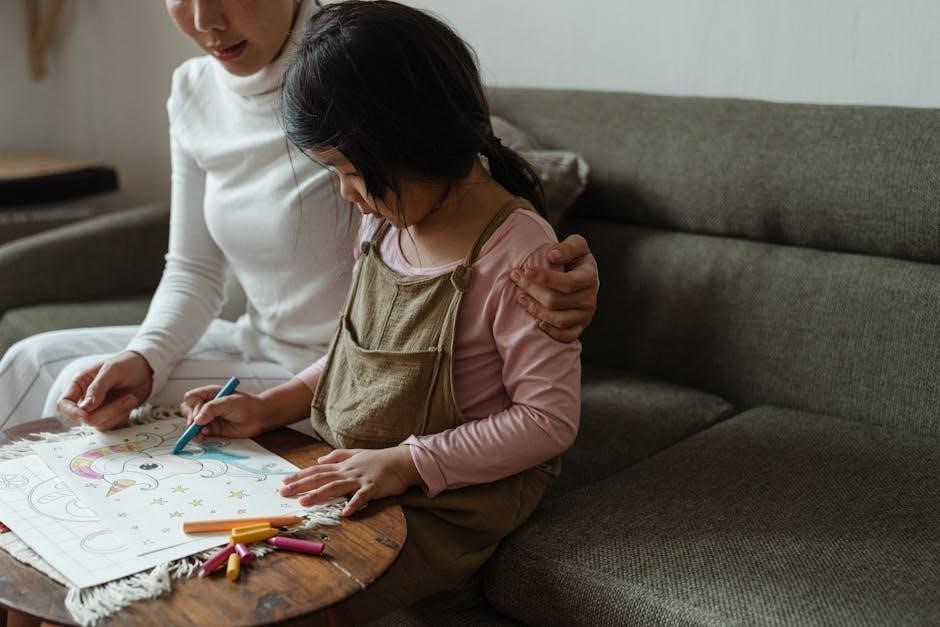Welcome to the Bound Parents Guide, where we explore the unique intersection of parenting and BDSM. This guide offers practical advice on balancing dual roles, maintaining privacy, and fostering open communication to create a harmonious and respectful household environment for all family members.
1.1 Understanding the Intersection of Parenting and BDSM
Parenting and BDSM present unique challenges when intertwined. Both roles require clear communication, consent, and boundaries. While parenting focuses on nurturing and protection, BDSM involves power dynamics and trust. Understanding this intersection helps create a balanced home environment where respect and open dialogue flourish, fostering healthy relationships for both children and adults alike.
1.2 Importance of Safety, Consent, and Privacy
Safety, consent, and privacy are foundational to balancing parenting and BDSM. Ensuring all activities are consensual and safe protects everyone involved. Privacy measures like locks and designated adult spaces maintain boundaries, while open communication fosters trust. These practices safeguard both family dynamics and intimate relationships, creating a secure and respectful environment for all household members to thrive.
Balancing Parental Responsibilities with BDSM Activities
Balancing parental responsibilities with BDSM activities requires careful planning, open communication, and teamwork. Separating family time and adult activities ensures harmony, safety, and fulfillment for all household members.
2.1 Separating Family Time and Adult Time
Separating family time and adult time is essential for maintaining balance. Designate specific hours for family activities, such as dinners or homework, ensuring they remain free from adult pursuits. Create a clear distinction by scheduling BDSM activities during children’s sleep or absence. This approach safeguards routines, providing a sense of security for kids while allowing adults to explore their interests responsibly and discreetly.
2.2 Creating a Sanctuary for Intimate Activities
Creating a sanctuary for intimate activities ensures privacy and separation from family life. Use locks and enforce knocking rules to protect personal space. Keep the area free from family items to maintain its adult purpose. Soundproofing and scheduling activities during children’s absence can enhance discretion. This sanctuary fosters a healthy environment for both family and adult roles, ensuring a balanced household.
Maintaining Privacy and Boundaries
Maintaining privacy and boundaries is essential for balancing family life and adult activities. Use locks, knocking rules, and verbal cues to protect personal space. Discreet practices and noise management help prevent exposure, ensuring a safe and respectful environment for all household members.
3.1 Locks, Knocking Rules, and Personal Space
Implementing locks on doors and enforcing knocking rules helps maintain privacy and personal space. These boundaries teach children respect for closed doors and adult-only areas. Consistent rules ensure clarity, while verbal cues like “occupied” or “do not disturb” reinforce the importance of privacy. This approach fosters a sense of security and respect for personal boundaries within the household, benefiting both children and adults alike.
3.2 Discreet BDSM Practices and Noise Management
Practicing BDSM discreetly involves using tools like soundproofing, pillows, and blankets to minimize noise. Scheduling sessions during children’s naptime or when they’re away ensures privacy. Quiet activities, such as rope bondage, are ideal for maintaining a low profile. These strategies help balance intimacy and family life, preserving a peaceful and respectful home environment for all members.
Teamwork in Parenting and BDSM Dynamics
Teamwork is essential for balancing parenting and BDSM roles, ensuring consistency and harmony. Collaboration fosters a united approach to discipline and intimacy, supporting both family and adult dynamics.
4.1 Presenting a United Front in Discipline
Presenting a united front in discipline is crucial for consistency and effectiveness. Parents and partners must collaborate to establish clear rules and consequences, ensuring children perceive authority as cohesive and reliable. This unity strengthens trust and security, while also modeling healthy relationship dynamics. Open communication and mutual respect within the disciplinary process foster a balanced and loving environment for all family members to thrive.
4.2 Communication and Partnership in Dual Roles
Effective communication and a strong partnership are essential for navigating dual roles as parents and BDSM participants. Open dialogue ensures alignment on boundaries, expectations, and household rules. Collaboration fosters mutual respect and trust, allowing both parenting and BDSM dynamics to coexist harmoniously. Regular check-ins and shared responsibilities strengthen the bond, ensuring a balanced and loving environment for all family members to flourish.

Educating Children About Consent and Respect
Educating children about consent and respect involves age-appropriate conversations and modeling healthy relationships, helping them understand boundaries and respect others’ autonomy.
5.1 Age-Appropriate Conversations About Boundaries
Talking to children about boundaries involves tailoring conversations to their age and understanding. For younger kids, simple explanations about personal space and consent are key. As they grow, discussions can expand to include respect for others’ autonomy and healthy relationship dynamics. Using relatable examples and fostering an open, non-judgmental environment helps children grasp these concepts effectively and builds a foundation for trust and respect.
5.2 Modeling Healthy Relationships
Modeling healthy relationships is crucial for children’s emotional development. Parents should express love, respect, and affection openly. Demonstrating positive interactions helps kids understand and emulate these behaviors. Handling their questions with honesty fosters trust and openness, creating a secure environment where they can develop healthy relationship models.

Managing BDSM Activities with Children at Home
Balancing BDSM practices with family life requires careful planning and discretion. Scheduling activities during children’s naptime or when they’re away ensures privacy and minimizes interruptions.
6.1 Scheduling and Timing of BDSM Practices
Effective scheduling is key to managing BDSM activities with children at home. Plan sessions during naptime, bedtime, or when kids are away. Noise reduction strategies, like soundproofing or quieter practices, help maintain discretion. Timing activities when children are occupied ensures privacy and minimizes interruptions, allowing for a more immersive and stress-free experience for all parties involved.
6.2 Handling Unexpected Situations Calmly
Unexpected interruptions, such as a child walking in, require calm and sensitivity. Remain composed, address the situation openly, and assess the child’s understanding before providing age-appropriate information. This approach avoids unnecessary trauma and maintains emotional security. Ensuring privacy while fostering trust helps navigate such moments smoothly, preserving both household harmony and the integrity of your BDSM dynamic.

Open Communication About Sex and Relationships
Open communication about sex and relationships fosters trust and understanding. Answering children’s questions honestly, age-appropriately, and without judgment helps build a secure environment, encouraging healthy curiosity and respect for intimacy.
7.1 Answering Children’s Questions Honestly
Answering children’s questions about sex and relationships honestly fosters trust and understanding. Providing age-appropriate, clear responses without shaming encourages healthy curiosity and respect for intimacy. This approach helps children develop a positive view of relationships and equips them with the knowledge to navigate their own experiences confidently and responsibly.
7.2 Normalizing Conversations About Intimacy
Normalizing conversations about intimacy helps children view relationships as natural and respectful. By discussing topics openly and age-appropriately, parents model healthy communication, fostering understanding and respect for personal boundaries. This approach encourages children to ask questions and seek guidance, creating a supportive environment for their emotional and social development effectively.

Demonstrating a Healthy BDSM Dynamic
Demonstrating a healthy BDSM dynamic involves showcasing mutual respect, trust, and consent. It highlights how power exchange can coexist with loving parenting, fostering a balanced and harmonious household.
8.1 Showcasing Mutual Respect and Consent
Mutual respect and consent are cornerstone values in both parenting and BDSM dynamics. By modeling healthy communication, active listening, and clear boundaries, parents demonstrate how respect fosters trust and harmony. This approach ensures that children witness and internalize positive relationship dynamics, creating a foundation for their understanding of healthy interactions and respect for others.
8.2 Balancing Affection and Discipline
Balancing affection and discipline in a household with BDSM dynamics requires intention and care. Parents must nurture a loving environment while setting clear boundaries and maintaining consistency. This balance teaches children the value of healthy relationships and respect for authority. Open communication and teamwork between partners ensure that affection and discipline coexist harmoniously, fostering emotional security and understanding for all family members.
Practical Tips for Navigating Dual Roles
Establish clear routines, prioritize quality time with both family and partner, and use discreet tools like locks or signals to manage dual responsibilities seamlessly and respectfully.
9.1 Prioritizing Relationship Quality
Regular check-ins with your partner ensure emotional connection and intimacy are maintained. Schedule dedicated time for both family and adult activities, using tools like shared calendars or discreet apps to balance roles seamlessly. Prioritizing quality over quantity fosters a strong, resilient relationship, essential for navigating dual responsibilities with harmony and mutual support.
9.2 Using Discreet Tools and Strategies
Employ soundproofing, noise-canceling headphones, and scheduling apps to manage BDSM activities discreetly. Use coded language or subtle gestures for communication, ensuring privacy without arousing curiosity. Discreet tools like lockable storage and hidden compartments maintain confidentiality, while strategic planning ensures activities align with family schedules, allowing for a seamless integration of dual roles without compromising either responsibility or intimacy.
By balancing parenting and BDSM, fostering open communication, and prioritizing respect, families can create a harmonious home. Education, boundaries, and teamwork pave the way for a loving, balanced environment where all members thrive.
10.1 The Importance of Education and Openness
Educating children about consent and boundaries is vital for their understanding of healthy relationships. Open conversations foster trust and respect, helping kids navigate future interactions confidently. By normalizing discussions about intimacy and providing practical tips, parents create a supportive environment where children thrive emotionally and socially, fostering a culture of trust and mutual respect in the household.
10.2 Embracing a Balanced and Loving Environment
Creating a balanced and loving environment requires intentional effort to harmonize parenting and BDSM dynamics. By fostering love, respect, and clear communication, families can thrive. Scheduling quality time for both family bonding and intimate activities ensures fulfillment in both roles. This balanced approach nurtures a secure, nurturing space where children and adults alike feel valued and supported, promoting long-term emotional well-being and happiness for all.
